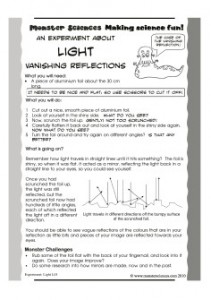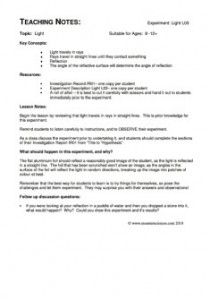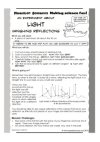Make your own mirror and then make your reflection vanish! A great way to learn more about how light travels.
 |
 |
What you will need:
- A piece of aluminium foil about the 30 cm long.
What you will do:
- Cut out a nice, smooth piece of aluminium foil.
- Look at yourself in the shiny side. What do you see?
- Now, scrunch the foil up. gently! Not too scrunched!
- Carefully flatten it back out and look at yourself in the shiny side again. Now what do you see?
- Turn the foil around and try again on different angles? is that any better?
What is going on?
Remember how light travels in straight lines until it hits something? The foil is shiny, so when it was flat, it acted as a mirror, reflecting the light back in a straight line to your eyes, so you could see yourself.
Once you had scrunched the foil up, the light was still reflected, but the scrunched foil now had hundreds of little angles, each of which reflected the light off in a different direction.
You should be able to see vague reflections of the colours that are in your reflection as little bits and pieces of your image are reflected towards your eyes.
Monster Challenges:
- Rub some of the foil flat with the back of your fingernail, and look into it again. Does your image improve?
- Do some research into how mirrors are made, now and in the past.
Teaching Notes:
Topic:
Light
Key Concepts:
- Light travels in rays
- Rays travel in straight lines until they contact something
- Reflection
- The angle of the reflective surface will determine the angle of reflection
Resources:
- Investigation Record IR01– one copy per student
- Experiment Description Light L03– one copy per student
- A roll of alfoil – it is best to cut it carefully with scissors and hand it out to students immediately prior to the experiment.
Lesson Notes:
Begin the lesson by reviewing that light travels in rays in straight lines. This is prior knowledge for this experiment.
Remind students to listen carefully to instructions, and to OBSERVE their experiment.
As a class discuss the experiment prior to undertaking it, and students should complete the sections of their Investigation Report IR01 from ”Title to “Hypothesis”.
What should happen in this experiment, and why?
The flat aluminium foil should reflect a reasonably good image of the student, as the light is reflected in a straight line. The foil that has been scrunched won’t show an image, as the angles in the surface of the foil will reflect the light in random directions, breaking up the image into patches of colour at best.
Remember that the best way for students to learn is to try things for themselves, so pose the challenges and let them experiment. They may surprise you with their answers and observations!
Follow up discussion questions:
If you were looking at your reflection in a puddle of water and then you dropped a stone into it, what would happen? Why? Could you draw this experiment and it’s results?



